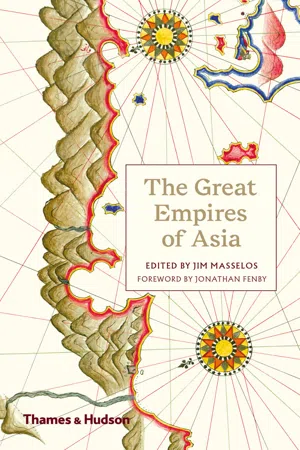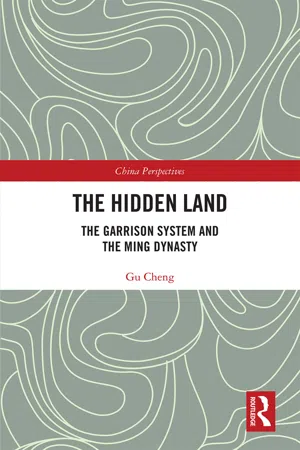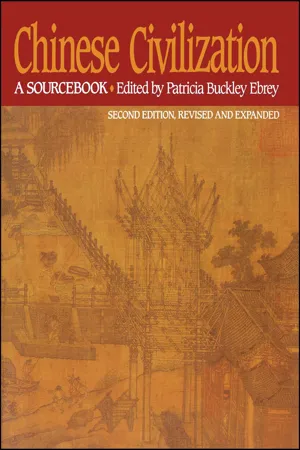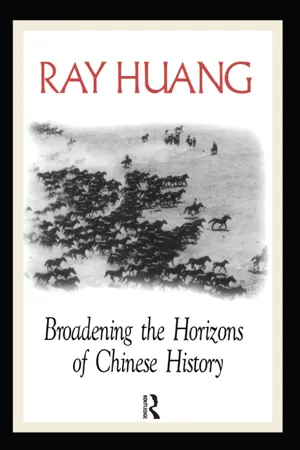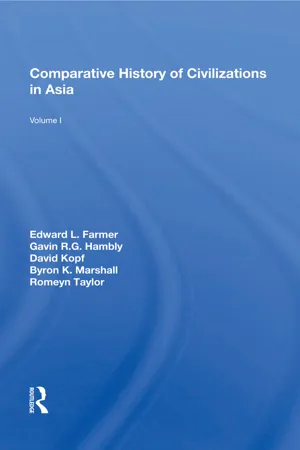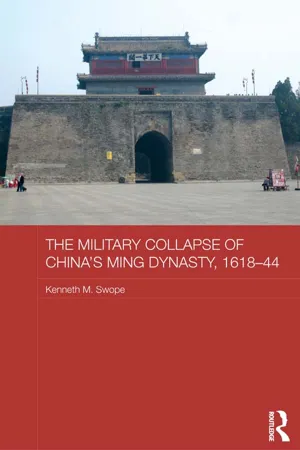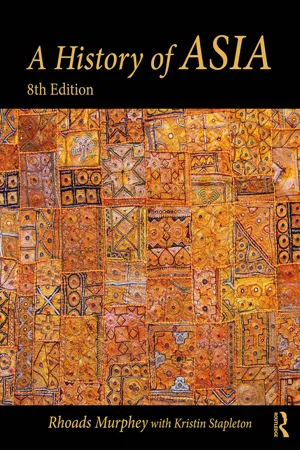History
Ming Dynasty
The Ming Dynasty was a ruling dynasty in China from 1368 to 1644, known for its cultural and artistic achievements, as well as its maritime exploration. It was a time of economic prosperity, technological advancements, and the construction of the Great Wall of China. The dynasty also saw the establishment of the Forbidden City in Beijing as the imperial palace.
Written by Perlego with AI-assistance
Related key terms
12 Key excerpts on "Ming Dynasty"
- eBook - ePub
- Jim Masselos, Jonathan Fenby(Authors)
- 2018(Publication Date)
- Thames and Hudson Ltd(Publisher)
CHAPTER TWO
J. A. G. ROBERTSChina: The Ming 1368–1644T he Ming Dynasty (ming means ‘brightness’) was the last native Chinese dynasty to rule China. It overthrew the Yuan, or Mongol, dynasty in 1368 and was in turn overthrown by the Qing, or Manchu, dynasty from Manchuria in 1644.The Ming period has been described as ‘one of the great eras of orderly government and social stability in human history.’1 For 276 years a population far greater than that of Europe enjoyed long periods of peace. The economy expanded, a dynamic urban culture developed and scholarship and art reached new levels of achievement. The period began with territorial expansion and ambitious maritime expeditions, but then turned to a defensivity marked by the construction of the Great Wall. Ming rule developed absolutist tendencies, which inhibited further political development. From about the middle of the 16th century a succession of ineffectual emperors, court intrigues, internal disorder and external threats were the characteristics of a long period of decline and fall.The Establishment of the Ming Dynasty
The dynasty came to power by overthrowing the Mongol Yuan dynasty that conquered north China early in the 13th century and the rest of China in 1279. Zhu Yuanzhang, who was to become the first Ming emperor, was born in 1328 in Nanjing province. This region had been badly affected by the silting up of the Grand Canal, and was also an area where the White Lotus sect, a Buddhist sect that anticipated the coming of a future Buddha, was very strong. From about 1340 White Lotus adherents, calling themselves the Red Turbans, turned to violence and Zhu Yuanzhang, whose parents had died of famine in 1344, was caught up in this movement. When in 1351 Toghto, the last effective Yuan leader, conscripted thousands of men to dredge the Grand Canal and re-route the Yellow River, a major Red Turban rebellion broke out. Zhu Yuanzhang joined one of the rebel bands, recruited men from his local region, and married the daughter of the leader of the band. His military ability led to his emergence as a major leader; one of his most famous battles was a naval engagement fought on the vast Poyang Lake. Unlike other Red Turban leaders, Zhu was willing to take advice from Confucian scholars. In 1356 he captured Nanjing and established a civil administration, severing his links with the Red Turban leadership. He proceeded cautiously and it was only in 1368, after the death of his main rivals, that he declared himself emperor and assumed the reign title of Hongwu. He sent an expedition north and forced the Yuan court to flee from its capital of Dadu, then in 1372 despatched a large force into Mongolia to prevent further Mongol incursions. The south western province of Sichuan, which had been occupied by a branch of the Red Turbans, was recaptured, the Korean state of Koryo, which had fallen under Mongol control, was forced to recognize the new dynasty, and in 1379 Tibet acknowledged the legitimacy of the new regime. - eBook - ePub
The Hidden Land
The Garrison System And the Ming Dynasty
- Cheng Gu, Ping Ning(Authors)
- 2019(Publication Date)
- Routledge(Publisher)
8 Forty years of studies on the Ming historySince the founding of the PRC, studies on the history of the Ming Dynasty have made considerable progress in both scope and depth. Many scholars believe that the decline of old China, from being advanced to becoming backward, began in the mid-Ming Dynasty. This historical reality motivates Chinese scholars to reflect and investigate.The Ming Dynasty lasted for a long period of 276 years. If we count from Zhu Yuanzhang’s rebellion to the conquest of the last Ming loyalists of the Southern Ming, the dynasty would span over three centuries. The Ming polity was a vast feudal country with multiple ethnicities. It was unified and highly centralized, but at the same time there was a clear imbalance of social, economic and cultural developments in different regions. There are countless issues worth studying and a vast amount of Ming documents available for virtually every research topic. Given the great number of research studies since the founding of the PRC, especially in the last ten years, it is impossible to discuss in one article all the research findings from this period. Therefore, this article will only address topics that have received more interest and attention in academia, focusing on the latest examples of progress.The social economy of the Ming period
Economic development is an important foundation for social development. The social economy of the Ming Dynasty is composed of various elements. The ones that have attracted most attention include the development of a commodity economy, the amount of cultivated land and kinds of land ownership, tax and corvée systems, and geographical and social mobility.- A commodity economy developed considerably after the mid-Ming. Since the 1950s, academics have carried out heated discussions on the sprouts of capitalism in China and have published many papers. Collections of treatises on this topic alone include Collected Papers on the Sprouts of Capitalism in China (two volumes, Joint Publishing, 1957), Collected Papers on the Sprouts of Capitalism in China, Additional Volume (Joint Publishing, 1960), Collected Papers on the Sprouts of Capitalism in Ming-Qing China (Shanghai People’s Publishing House, 1981) and Collected Papers on the Sprouts of Capitalism in China
- eBook - ePub
Chinese Civilization
A Sourcebook, 2nd Ed
- Patricia Buckley Ebrey, Patricia Buckley Ebrey(Authors)
- 2009(Publication Date)
- Free Press(Publisher)
PART V
THE Ming DynastyAfter the Mongol empire broke apart and the Yuan dynasty collapsed, a Chinese dynasty was founded, the Ming (1368-1644). The early Ming was a period of recovery from some of the setbacks of Mongol rule, but many Yuan institutions were retained, since the forms and institutions of the Song could not be directly or fully restored. The Mongol capital at Beijing was made the Ming capital in 1421 and except for brief intervals has remained the capital of China until today. Economic revival led to a high level of commercial activity and handicraft production, but not to the innovative spirit of the early Song. Nevertheless, the Ming seems to have been one of the most prosperous periods of Chinese history. It was during these centuries that the great potential of south China came to be fully exploited. New crops such as cotton, maize, and sweet potato came to be widely cultivated, and industries such as porcelain and textiles flourished.The Ming is generally considered the first truly despotic or autocratic Chinese dynasty (if the Yuan is considered an alien dynasty). The problems of central control of a huge, complex empire appeared pressing to the early emperors, who were intent on assuring personal control of the machinery of the bureaucracy and finding ways to keep the officials in line. The Jurchen and Mongol innovation of provincial governments, consisting of branches of the central government, was developed further as a way to cope with the difficulty of direct central control of the whole empire. The censorate, imperial guard, and eunuchs were all used to keep the emperor informed of possible wrongdoing throughout the country. The arbitrary actions of the emperors undoubtedly demeaned the status of high officials and often jeopardized their welfare, but would have had less impact on villagers, whose affairs were still left pretty much to elders and local notables.Sources for the Ming are even more varied than for the Song. Particularly valuable are genealogies, charters, and other records of group activities which show the proclivity of peasants and townsmen to form corporate groups of various sorts, such as lineages, guilds, village associations, and secret societies. Such groups were probably common before the Ming, but they cannot be as well documented until then. The major reason for forming corporate groups seems to have been to gain protection from the casual mistreatment or exploitation of officials, large landowners, rich merchants, and other powerful people. Once one group of people had organized to protect their own interests, others would imitate them so as not to be left isolated. Indeed, by the Ming there is evidence that isolated individuals, without groups to support them, often lived precarious lives or had to put themselves under the protection of a landlord or employer who could take advantage of their weak position. - eBook - ePub
Broadening the Horizons of Chinese History
Discourses, Syntheses and Comparisons
- Ray Huang(Author)
- 2016(Publication Date)
- Routledge(Publisher)
The History of the Ming Dynasty and Today’s WorldAfter several decades of hard and intense work by scholars in and out of China, the history of the Ming Dynasty is no longer an immature field. This situation I have not hesitated to take advantage of. Benefiting from the wide circulation of reprinted source material and the appearance of a large number of monographs and articles on the period, my small book, 1587, A Year of No Significance, tries to present a profile of the dynasty in its late stage. The compilation is made possible by the voluminous data on hand, which would not have been so readily available even a short time ago.True, there is no limit to the depth of factual details that historians may endeavor to unearth. At this point, however, we can at least claim that a general picture of Chinese society in the late sixteenth century is within our power to present.With a slight touch of crudeness, we can even assert that the society in description is a submarine sandwich. The long piece of bread on the top is the literary bureaucracy and the long piece of bread on the bottom is the peasantry, both enormous and undifferentiated. Simplicity and uniformity being its structural features, this traditional organization is fostered by a legal code that gives deference to the imperial patentee over the commoner, the male over the female, and the aged over the young. The link between the top and the bottom, provided by the civil service examinations, affirms those principles. While successful in warding off all the possible complexities, such a social order from today’s viewpoint can never escape the criticism of being obsolete and uninspiring. - eBook - ePub
Harmony and War
Confucian Culture and Chinese Power Politics
- Yuan-kang Wang(Author)
- 2010(Publication Date)
- Columbia University Press(Publisher)
5 THE Ming Dynasty (1368–1644)CHINA DURINGthe Ming Dynasty was much more powerful than its neighbors, which was not so in the Song dynasty. For a good part of the region’s history, Ming China was the regional hegemon in East Asia. Yet it built the Great Wall, a defensive fortification that has become a national symbol of China. Proponents of Confucian pacifism assert that China did not pursue offensive strategies when it was powerful and that the Great Wall was the best proof of a consistently defensive posture even when Chinese power was preponderant. The extraordinary strength of Ming China permits us to test this claim. Has Confucian culture kept China from pursuing an offensive grand strategy during periods of military superiority?Ming China’s main security threat came from the northern border. The Mongols, who had conquered China and established the Yuan dynasty (1279–1368), withdrew to the steppe after being overthrown by Chinese rebels and yet remained a formidable adversary. Debates about how to deal with the Mongol problem dominated Ming national security decision making. Founding Emperor Hongwu (r. 1368–1399) in his Ancestral Injunctions (Huang Ming Zu Xun), which were meant to be the guideline of foreign policy for future generations of Ming leaders, exhorted his successors to guard against the Mongol threat: “As for the [nomadic] barbarians who threaten China in the north and west, they are always a danger along our frontiers. Good generals must be picked and soldiers trained to prepare carefully against them.”1The Ming Dynasty implemented the civil service examination system that put Confucian scholar-officials in the central leadership. These officials were well versed—and socialized—in the humane and antimilitarist precepts of the Confucian classics. If culture influences strategic choices, given the preeminence of Confucian discourse among policy elites, we expect to observe a clear pattern of antimilitarism in the Ming security policy. That is, contrary to realist predictions, when presented with an opportunity to use force, the Ming would not take advantage of it. Instead, it would exercise restraint and choose less coercive measures. As the Ming grew more powerful, it would not become more aggressive and use the increased capacity to take offensive actions against the Mongols. Instead, it would adhere to a defensive posture and rely on low-coercive policies that demonstrated the benevolence and awesomeness of the Chinese empire. Chinese initiation of conflict would remain few and far between. Finally, even when the Ming was involved in a conflict with the Mongols, it would aim to restore the status quo ante rather than destroy the Mongols or annex more territories. Chinese war aims would not expand beyond original border protection. - eBook - ePub
- Edward L. Farmer(Author)
- 2019(Publication Date)
- Routledge(Publisher)
Another effect of Ch'ien-lung's book burning was to deflect Chinese scholarship away from sensitive issues. Already by the end of the Ming, scholars were in reaction against the idealism of the Wang Yang-ming school, which stressed the mind. Late Ming and early Ch'ing scholarship turned increasingly to concrete subjects like geography, history, and bibliography. The result was Ch'ing empiricism—a rigorous and systematic scholarship that was protoscientific in its rules for collection of data, use of evidence, and citation of sources. It did not include experimentation, however, and there was little interest in the realm of nature. The favored subject matter was the literary tradition itself, and some of the greatest achievements were in areas like philology, phonology, lexicography, and textual analysis of the classics. Thus by the twin sanctions of sponsorship and suppression, the Manchu state was able to channel the energies of the Chinese literati into harmless endeavors. As scholarship became less relevant to the issues of the day it also declined in vigor and creativity.In China the era of the early modern empires saw a continued development of the centralized power of the imperial state. The Ming, which arose in response to Mongol rule, was self-conscious in its culturism. The state took an active role in the promotion of Chinese high culture and in stabilizing the social and administrative institutions of the empire. The jurisdiction of the Ming was essentially China proper, an area the state governed and defended as a self-contained island of cultural superiority. The Manchu conquest in the seventeenth century reduced the Chinese to the status of a subordinate, though large, majority within a pluralistic Ch'ing empire. The Manchu rulers assiduously adopted and promoted the Ming forms but transformed them to the needs of a foreign rule. The result in the first century and a half was a prosperous empire under stable and capable administration. Under the Ch'ing government, China attained in the eighteenth century its greatest prosperity—perhaps the greatest wealth known to any society in history up to that time. Internal peace and moderate levels of taxation contributed to a doubling of the population from 150 million to more than 300 million by the end of the century. In subsequent chapters we will have cause to note that the very successes of the Ming and Ch'ing governments created problems for China in the nineteenth century. Ming institutions worked so well that innovation was hard to justify or even to conceive, Manchu cultural policy was so effective that the Chinese were tardy in developing a sense of nationalism, and the growth of population undermined the prosperity of the whole society. - eBook - ePub
- William Guanglin Liu(Author)
- 2015(Publication Date)
- SUNY Press(Publisher)
Part IIIThe Ming Era
Passage contains an image Chapter 5
China after 1200
Crisis and DisintegrationChina in the three centuries from 1200 to 1500 witnessed a shift from a Kaifeng-centered market system to a Beijing-centered command power. The Mongol conquest of China (1206–1279) and the rise of an autocratic regime in early Ming China from 1368 onward were the most important events that contributed to the downward turn in the Chinese market economy during the next three and half centuries.1 Both census and taxation data vividly reveal how radically aggregate population and urbanization during these four centuries declined. The Mongol conquest, especially the wars between the Mongols and Jurchens from 1211 to 1234 in the north, dealt a devastating blow to the economy. The conquest of the Southern Song in South China was much less destructive, but the military campaigns took an unavoidably heavy toll on the upper- and mid-Yangtze region. In terms of interregional trade, the Kaifeng-centered water transportation regime ended in 1125 when Jurchen troops occupied North China. From then on until Zhu Yuanzhang established the Ming Dynasty in 1368, China was ravaged by continuous wars and natural disasters. Consequently, early Ming aggregate households as of 1393 amounted to only 6 million, merely 29 percent of the Song registered households recorded in 1109.2In this chapter I reassess the post-1200 economic crisis in a full-scale view. The story I tell about China in these centuries is far more than a demographic one. Nor is it about an economic downturn in a short period. After the Mongol conqueror unified China under the Yuan dynasty, there was an odd discord between the ever-expanding size of the empire and the integration of the national economy. In the centuries after the Mongol conquest, Chinese imperial power greatly expanded territorially and marched far into Central Asia. For the first time, Beijing, a frontier city once repeatedly subjected to nomadic conquests, became the imperial capital. However, with the sharp decline in aggregate population and anti-market policies implemented by the early Ming court, the Chinese economy greatly disintegrated. The recovery, especially the recovery of long-distance trade, was to be delayed until the 1500s, and this recovery was confined to just a few major inland waterways.3 - Kenneth M. Swope(Author)
- 2014(Publication Date)
- Routledge(Publisher)
8 The fall of the Ming from a global perspectiveThe fall of the Ming Dynasty has captivated people for centuries. After all, how could the wealthiest, most powerful empire in the world succumb to ragtag bands of peasant rebels and recently unified tribal peoples from a backward frontier? Traditionally the fall of the Ming was couched in the standard terms of the dynastic cycle, whereby a corrupt, ossified regime collapsed in upon itself and a more vigorous government that served the interests of the people came in to take its place and restore order. Of course, as the present work has hopefully demonstrated, matters were far more complicated than this. As the authors of The Cambridge History of China volume on the Ming observed more than two decades ago, “any attempts to pass over late Ming history with facile references to the inexorable workings of the dynastic cycle should be quickly and firmly rejected.”1 There were a multitude of reasons for the fall of the Ming Dynasty, some of which had something in common with earlier dynastic collapses, but many of which were specific to the era in question. Most importantly, recent scholarship has identified the great degree to which the Ming were integrated into wider world developments, both economically and ecologically. Many of these developments were far beyond the capacity of the Ming, or indeed any government, to anticipate or direct. The present study has endeavored only to illuminate the military dimensions of the collapse because previous works, most notably Frederic Wakeman’s magisterial The Great Enterprise- eBook - ePub
- Jun Teng(Author)
- 2018(Publication Date)
- Routledge(Publisher)
5 Sino-Japanese cultural exchanges during the Ming DynastyAshikaga Yoshimitsu builds the golden Pavilion: he overrides all objections to develop licensed trade with the Ming Dynasty
The ancient Sino-Japanese cultural exchange mainly focused on material during the dynasties of Qin and Han, political system in the periods of Sui and Tang, and religious culture during the Song and Yuan dynasties. Till the Ming and Qing periods, the exchange was about folk customs and economy and trade.The Ming Dynasty was founded by Zhu Yuanzhang in Nanjing in 1368 and replaced by the Qing Dynasty in 1644 when Li Zicheng occupied Beijing, which existed in history for about 270 years. The Ming Dynasty, then the most powerful country in the world, kept close relations with the other Asian countries. Zheng He’s voyages1 (1405–1433) strengthened the relations between the Ming Empire and Asian and African countries. At the same time, Japan experienced the periods of Nanboku-chō (1336–1392), Muromachi (1392–1573), Sengoku (1467–1568), Azuchi-Momoyama (1573–1603), and Edo (1603–1867). The Ming Dynasty as a unified regime was clear about its establishing diplomatic relations with Japan. Japan, however, saw frequent political strives between different regimes, each of them having different political purposes. Therefore, the relations between Ming China and Japan in this period can be divided into the following four stages:- From 1368 to 1403, no formal diplomatic relations were established between the Ming Dynasty and Japan.
In 1368, when the Ming Dynasty was just founded, Emperor Taizu of Ming sent envoys to Japan, requiring that the coastal Japanese pirates be suppressed. Kyushu then was controlled by Prince Kaneyoshi, a general of the Southern Court. He believed that the envoys were sent by the Mongols of the Yuan Dynasty, so he turned them down. The next year, Emperor Taizu of Ming sent another seven-member diplomatic mission headed by Yang Zai. In the letter, the Chinese emperor told the Japanese general that the Yuan Dynasty had been replaced by Ming and condemned the Japanese pirates’ invasion. “Your visit to my court is expected; otherwise, troops will be sent to conquer your country and suppress the pirates”. After reading the letter, Prince Kaneyoshi killed five of the Chinese envoys and imprisoned the other two (Yang Zai and Wu Wenhua) for three months. In 1370, the Ming emperor sent Zhao Zhi to Japan. When Prince Kaneyoshi was going to kill Zhao, Zhao looked fearless, saying, “My emperor is virtuous and brilliant, and with whom the Yuan Mongolians couldn’t be compared. I am not an envoy from the Yuan court as you thought. If you want to kill me, just do it”. Upon hearing Zhao’s words, the Japanese general laid down his sword. Prince Kaneyoshi realized he could benefit a lot if he established close relations with the Ming Court. Therefore, in 1371, he sent people to Nanjing, taking with them tributes and more than 70 Chinese people they had imprisoned. What he did was rewarded by the Ming emperor. Since then, from 1371 to 1386, Japanese envoys were sent to pay tributes to the Ming Court in Nanjing ten times, some of whom claiming themselves to be powerful lords in Kyushu. Emperor Taizu of Ming had learned from various sources that Japan then was in a state of division and confrontation. The Southern Court was the orthodox power. As for the southern general Prince Kaneyoshi guarding Kyushu was only a regional force. From then on, the Ming Court started to turn down the Japanese envoys.
- eBook - ePub
- Stephen G. Haw(Author)
- 2006(Publication Date)
- Routledge(Publisher)
5 Chinese capital: The Ming Dynasty, 1368 to 1644
Shortly before his armies took Dadu, Zhu Yuanzhang had declared himself the first emperor of a new dynasty, the Ming. He is usually known as the Hongwu Emperor, although in fact ‘Hongwu’ is not a name, but the title of a reign-period. Reign-periods had been in use in China for many centuries for dating the years. Thus, a particular year might be ‘the fifth year of the Yuanfeng period’. The Western calendar dating years from the birth of Christ was of course not used in China until recent times. During previous dynasties, reign-periods were often changed during the reign of one emperor, but during the Ming Dynasty and the Qing dynasty that followed it, only one reign-period was used throughout the whole of the reign of each emperor. It has become common practice to refer to emperors of these dynasties by the title of their reign-period, as if it were their name.Dadu becomes Beiping
The Hongwu Emperor had established himself in Nanjing, then called Yingtian, in 1356. Twelve years later, in the same year that he proclaimed his new dynasty, he renamed it Nanjing, meaning ‘Southern Capital’. Kaifeng, the old capital of the Song dynasty, became his Northern Capital, Beijing. The former Mongol capital of Dadu was given the name Beiping. The founder of the Ming Dynasty, it would seem, never had any intention of using the old Mongol capital of Dadu as even a subsidiary capital of his new, Chinese dynasty. There was really no reason why he should have wished to do so. Dadu or Beiping was in the far north-east of his empire, a long way from its centre. The water supply for the city was barely sufficient and it could only be supplied with enough food by transporting grain over long distances. During the last twenty years or so of the Yuan dynasty, disorder in the Yangtze valley region had stopped the movement of grain northwards to Dadu. There had been famine in the city as a result. The Mongol Grand Canal had fallen into disuse and disrepair. Parts of it had been severely damaged by flooding and changes of course of the Yellow River. To make the city viable as a capital again would require the renovation of the Grand Canal, a major undertaking. Nanjing was a practical site for the principal capital of the empire, for it lay on the Yangtze River, in the area that had by this time become the chief grain-producing region of China. There was no shortage of water, either. Communications with the rest of the empire were relatively easy from Nanjing. The Yangtze River and its major tributaries allowed direct water-borne communication with a large part of China. Nanjing was also a long way from the northern borders, where the Mongols continued to pose a threat. As it lay on the south bank, any invaders from the north would have to cross the wide Yangtze River to attack it. The Hongwu Emperor made a good choice of capital. It seemed that Beiping was destined to revert to being an important regional centre, but nothing more. - eBook - ePub
- F. W. Mote(Author)
- 2003(Publication Date)
- Harvard University Press(Publisher)
Beyond the adjacent regions in which China might on occasion be militarily active was a more distant world of less direct contacts. Admiral Zheng He’s extraordinary exploits in the first third of the fifteenth century brought China into expanded diplomatic contacts with many states and statelets from the coasts of Southeast Asia to India, the Persian Gulf, and Africa. Whatever potential that kind of state-sponsored maritime activity might have had for broadening China’s international horizons, after the 1430s the government abandoned those great maritime expeditions, although it continued to send envoys to the nearer states, often by sea. In the sixteenth century the sea lanes Zheng He had explored a century earlier now began to bring Europeans into South and East Asia and to China; more important, goods and products and ideas from distant places came to affect the lives of the Chinese in new ways. Modern China’s dramatically changing place in the world can be dated from this century. Ming China had to make the first adjustments to that larger world without knowing, or having a way to know, that the world around it would never be the same again. Two centuries later the Qianlong emperor, who reigned 1736–1795, began to sense the full significance of that changing world, but he remained uncertain how to deal with it and ineffectual in his attempts.Here Ming China’s land frontiers on three sides will first be surveyed. Then the maritime frontier on the east will complete this tour of Ming China’s horizons.II . TENSION AND PERIL ON THE NORTHERN BORDERSRelations with the Mongols dominated Ming China’s northern frontiers throughout the dynasty until its last thirty years; then the Jurchens, only slowly recognized as a more immediate source of danger, superseded the threat long associated exclusively with the Mongols. In 1635 the Jurchen khan officially changed his people’s name to Manchu. With much Mongol assistance, a group of newly united Manchu tribes then subjugated both the Mongols and the Chinese to create a vast empire of Inner Asian and Chinese extent; we know it as the Qing dynasty. As will become clear in subsequent chapters, groups of Jurchens and certain Mongol tribes had lived side by side in the Northeast (which we usually call Manchuria) and in adjoining portions of Mongolia throughout the Ming period; both participated in the tribute system pattern of Chinese foreign relations, were deeply involved with China, and were eager for the trade and other benefits which that system made possible. Until the early seventeenth century, however, we can discuss the northern border problems exclusively as a Mongol-Chinese problem.To understand Ming-Mongol relations it is necessary to look at the problems from the quite different points of view of all the participants. That is consistent with the attempt I have made throughout this book when discussing non-Chinese peoples who have played important roles in Chinese history; the other side of such problems, seldom given much consideration by Chinese of the time, and often quite distorted by present-day Chinese and other historians, must be brought within our awareness. It is nowhere more important than in the history of Ming relations with the Mongols. - eBook - ePub
- Rhoads Murphey, Kristin Stapleton(Authors)
- 2019(Publication Date)
- Routledge(Publisher)
A rival rebel leader named Zhang had meanwhile been raiding and plundering over much of north China with hit-and-run tactics that the Ming armies were unable to cope with. In 1644 he invaded Sichuan, set up a government, and moved to claim the throne himself. His power plays and his terror tactics, however, lost him the support of the gentry, whom he saw as rivals for power, and without them on his side his cause was lost. But the Ming had really defeated themselves by ignoring the basic functions of any government—namely, to govern and to serve their subjects.THE MANCHU CONQUESTBeyond the Great Wall in Manchuria, a non-Chinese steppe people, the Manchus, descendants of the Jurchen who had conquered the Northern Song, had risen to power despite earlier Ming efforts to keep them divided and subdued. A strong leader, Nurhaci (1559–1626), united several previously separate tribes and founded a Chinese-style state, taking the title of emperor and promoting the adoption of the entire Confucian system and its philosophy. His capital was established at Mukden (now called Shenyang) in southern Manchuria, where his two sons, also capable people, succeeded him and continued to build a powerful state and military.By 1644 the Manchus had assimilated much of Ming political culture, although they retained their own language, religion, and social customs. They controlled the whole of Manchuria as far south as Shanhaiguan, where the Ming Great Wall meets the Gulf of Bohai. Their administration and army included large numbers of Chinese, who accurately saw them as a coming power and as a far more effective state than the Ming had by then become. The Manchus made vassals of the Mongols of Inner Mongolia and of Chosŏn Korea, after expeditions had conquered both. They were consciously building their power to take over China, and in 1644 they had their opportunity.A Ming general, Wu Sangui, confronted with the rebel forces of Li Zicheng, who now occupied Beijing, invited the Manchu armies waiting on the border at Shanhaiguan to help him defeat the rebels. Having done so handily, the Manchus remained to found the Qing dynasty, rewarding a number of Chinese collaborators with grants of land. Some of these collaborators later rebelled but were suppressed in heavy fighting. The offshore island of Taiwan (Formosa), served as a base of resistance against the Qing after the Ming loyalist Koxinga (Zheng Chenggong) wrested it from Dutch colonizers. Many southern Chinese fled to Taiwan to escape Qing rule. In 1683 the Qing conquered the island, incorporating it and its mixed population of Chinese and indigenous peoples into the expanding empire. It thus took nearly another 40 years after 1644 before all Chinese resistance to the Manchu conquest was eliminated.
Index pages curate the most relevant extracts from our library of academic textbooks. They’ve been created using an in-house natural language model (NLM), each adding context and meaning to key research topics.
